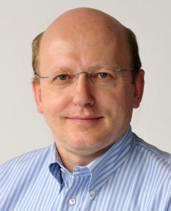Speaker: Prof. Dr. Holger T. Grahn
Time: Friday 9:30 a.m., 22th Sept.
Place: A718 SINANO
Abstract:  The high-quality growth of complex planar semiconductor heterostructures with more than one thousand layers with individual thicknesses down to one nanometer has resulte0d in the development of terahertz quantum-cascade lasers. During the last decade, these lasers have been used as radiation sources for modulation spectroscopy, local oscillators in hetero-dyne receivers for astronomy, and sophisticated terahertz imaging techniques despite the necessary cryogenic operation. The majority of terahertz quantum-cascade lasers is based on GaAs/(Al,Ga)As heterostructures with an Al content between 0.1 and 0.25. By replacing the ternary (Al,Ga)As by binary AlAs layers, we have recently demonstrated a more than three times larger wall plug efficiency for GaAs/AlAs than for GaAs/(Al,Ga)As quantum-cascade lasers. These lasers are promising candidates for the local oscillator in an advanced multi-channel heterodyne receiver at terahertz frequencies on board of the Stratospheric Observatory For Infrared Astronomy (SOFIA).
The high-quality growth of complex planar semiconductor heterostructures with more than one thousand layers with individual thicknesses down to one nanometer has resulte0d in the development of terahertz quantum-cascade lasers. During the last decade, these lasers have been used as radiation sources for modulation spectroscopy, local oscillators in hetero-dyne receivers for astronomy, and sophisticated terahertz imaging techniques despite the necessary cryogenic operation. The majority of terahertz quantum-cascade lasers is based on GaAs/(Al,Ga)As heterostructures with an Al content between 0.1 and 0.25. By replacing the ternary (Al,Ga)As by binary AlAs layers, we have recently demonstrated a more than three times larger wall plug efficiency for GaAs/AlAs than for GaAs/(Al,Ga)As quantum-cascade lasers. These lasers are promising candidates for the local oscillator in an advanced multi-channel heterodyne receiver at terahertz frequencies on board of the Stratospheric Observatory For Infrared Astronomy (SOFIA).
Biography:
Prof. Dr. Holger T. Grahn
Head of Department Semiconductor Spectroscopy at the Paul Drude Institute for Solid State Electronics in Berlin
Adjunct Professor at the Institute for Solid State Physics, Berlin Institute of Technology
Habilitation in Physics: Friedrich-Alexander-University Erlangen-Nürnberg, Germany, 1993
Ph. D. in Physics: Brown University, Providence, Rhode Island, USA, 1987
Sc. M. in Physics: Brown University, Providence, Rhode Island, USA, 1984
M. Sci. in Physics: Christian-Albrechts-University Kiel, Germany, 1983
downloadFile
